National Unity Day (Rashtriya Ekta Diwas): National Unity Day is celebrated every year on 31st October to commemorate the birth anniversary of Sardar Vallabhbhai Patel. It is also known as Rashtriya Ekta Diwas. The reason behind the celebration of this day is to make people aware of the ideas of staying together and uplifting society. It was celebrated for the first time in 2014.
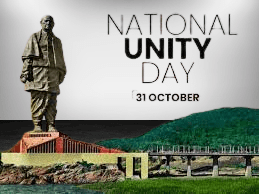
National Unity Day
In 2023, 31st October India will mark the 148th birth anniversary of Sardar Vallabhbhai Patel, who is also known as the Iron Man of India.
The Rashtriya Ekta Diwas or National Unity Day provides an opportunity to reaffirm the inherent strength and resilience of our nation towards upholding the unity, integrity, and security of our country. In honour of Sardar Vallabhbha Patel, the government of India in 2018 constructed the world’s tallest statue of Sardar Vallabhbhai Patel near the Narmada River in Gujarat which symbolizes the strength of unity in India to mark the 143rd birth anniversary of Sardar Patel.. The main objective of the celebration is to uplift the nation’s unity and spread awareness about Sardar Vallabhbhai Patel’s contribution to Indian history.
- The Statue of Unity is the tallest statue in the world. At 182 meters, it is 23 meters taller than China’s Spring Temple Buddha statue and almost double the height of the Statue of Liberty (93 meters tall) in the US.
- In January 2020, it was added to the ‘Eight Wonders’ of the Shanghai Cooperation Organization (SCO).
The Rashtriya Ekta Diwas or National Unity Day was introduced by the Indian government in 2014 to pay tribute to Sardar Vallabhbhai Patel on his birth anniversary for his extraordinary work in keeping India united. The first Rashtriya Ekta Diwas event was inaugurated by Prime Minister Narendra Modi who flagged of a program, ‘Run for Unity’ in New Delhi in 2014.
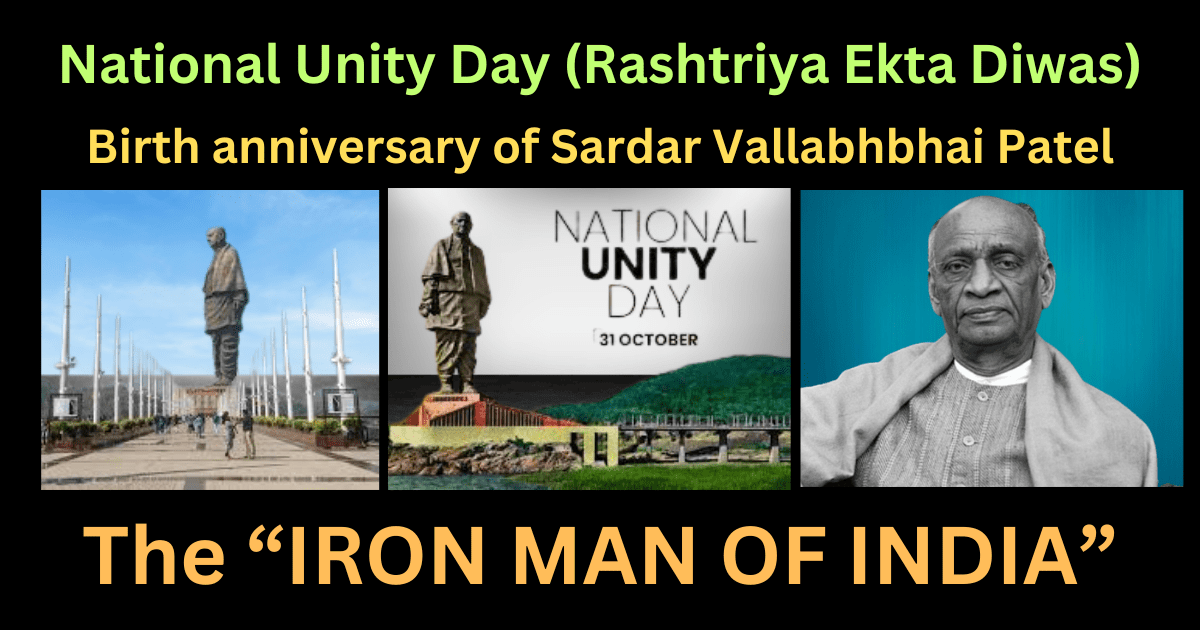
The official statement for National Unity Day by the Home Ministry of India cites that the National Unity Day “will provide an opportunity to re-affirm the inherent strength and resilience of our nation to withstand the actual and potential threats to the unity, integrity, and security of our country.”
On the day, a pledge is read out in government offices:
I solemnly pledge that I dedicate myself to preserving the unity, integrity, and security of the nation and also strive hard to spread this message among my fellow countrymen. I take this pledge in the spirit of the unification of my country which was made possible by the vision and actions of Sardar Vallabhbhai Patel. I also solemnly resolve to make my own contribution to ensure the internal security of my country.
Sardar Vallabhbhai Patel
Vallabhbhai Jhaverbhai Patel commonly known as Sardar Vallabhbhai Patel, was an Indian independence nationalist and barrister who served as the first Deputy Prime Minister and Home Minister of India from 1947 to 1950.
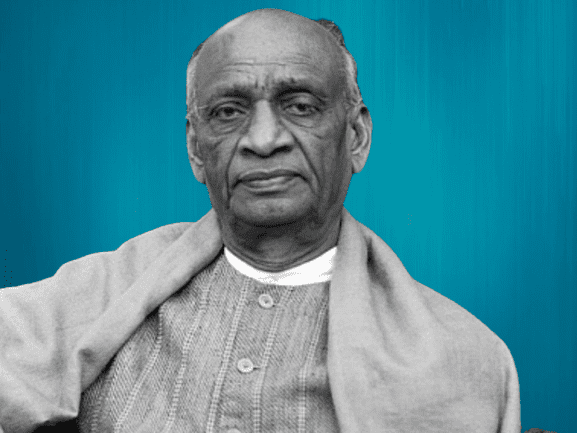
Sardar Vallabhbhai Patel, the iron man of India, was born on October 31, 1875, in Nadiad, Kheda district of Gujarat. He was a successful barrister, a Senior Congress leader and one of the prominent figures of India’s freedom struggle movement. A staunch congressman, the first deputy Prime Minister of India, Sardar Vallabhbhai was a true Gandhian who was committed to the unity and integrity of India. He played an exemplary role in the integration of 565 princely states to the union of India and was proudly regarded as the Iron Man of India.
After completing his education in England, he returned to India and settled in Ahmedabad and became one of the city’s most successful barristers. He was not keen to join add politics but On Gandhi’s call, Patel quit his hard-earned job, joined the Congress party and joined the movement to fight for exemption of taxes in Kheda at the time of plague and famine (1918). During the Non-Cooperation Movement (1920), he actively participated and recruited 3 lakh volunteers to the Congress Party and collected a sum of Rs. 1.5 million for party fund. When Gandhi ji was imprisoned in 1923, it was Sardar Patel who led the Satyagraha against the British law of banning the hoisting of India’s flag.
| Sardar Vallabhai Patel BIOGRAPHY | |
| Birth Name | Vallabhbhai Jhaverbhai Patel |
| Birth Date | 31 October 1875 |
| Birth Place | Nadiad (Gujurat), Bombay Presidency, British India |
| Father | Jhaverbhai Patel |
| Mother | Ladba |
| Spouse | Jhaverben Patel ( Married in 1893, Died in 1909 ) |
| Profession | Lawyer/Barrister |
| Children | daughter, Maniben, in 1903 and a son, Dahyabhai, in 1905 |
Sardar Patel became the household name after the Bardoli Satyagraha (1928) which earned him the title of ‘Sardar’.
He is also remembered as the ‘Patron saint of India’s civil servants’ as he established the modern all-India services system.
After suffering a massive heart attack (his second), Patel died on 15 December 1950 at Birla House in Bombay.
Patel was posthumously awarded the Bharat Ratna, India’s highest civilian honour, in 1991.
It was announced in 2014 that his birthday, 31 October, would become an annual national celebration known as Rashtriya Ekta Diwas (National Unity Day)
In 2012, Patel was ranked third in Outlook India’s poll of the Greatest Indian.
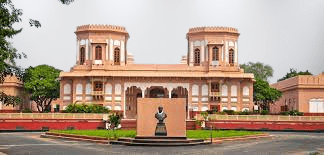
The Sardar Vallabhbhai Patel National Memorial in Ahmedabad was established in 1980 at the Moti Shahi Mahal. It comprises a museum, a gallery of portraits and historical pictures, and a library containing important documents and books associated with Patel and his life.
The international airport of Ahmedabad is named after him.
Also the international cricket stadium of Ahmedabad (also known as the Motera Stadium) is named after him.
The Gujarat government’s institution for training government functionaries is named Sardar Patel Institute of Public Administration
Statue of Unity
The Statue of Unity is a monument dedicated to Sardar Vallabhbhai Patel, located in the Indian state of Gujarat, facing the Narmada Dam, 3.2 km away from Sadhu Bet near Vadodara. At the height of 182 metres (597 feet), it is the world’s tallest statue, exceeding the Spring Temple Buddha in China’s Henan provinceby 54 meters. The previous tallest statue in India was the 41 m (135 ft) tall statue of Lord Hanuman at the Paritala Anjaneya Temple near Vijayawada in the state of Andhra Pradesh. The statue can be seen within a 7 km (4.3 mi) radius.
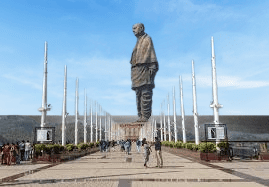
This statue and related structures are spread over 20,000 square meters and are surrounded by an artificial lake spread across 12 km and cost an estimated 29.8 billion rupees ($425m). It was inaugurated by India’s Prime Minister Narendra Modi on 31 October 2018, the 143rd anniversary of Patel’s birth. The height of the statue in meters has been picked to match the total assembly constituencies in Gujarat.
The Statue of Unity is the world’s tallest statue, with a height of 182 metres (597 feet), located near Kevadia in the state of Gujarat, India. It depicts Indian statesman and independence activist Vallabhbhai Patel. He was the first deputy prime minister and home minister of independent India. The statue is located in Gujarat on the Narmada River in the Kevadiya colony, facing the Sardar Sarovar Dam 100 kilometres (62 mi) southeast of the city of Vadodara.
The project was first announced in 2010, and construction started in October 2013 by Indian company Larsen & Toubro, with a total construction cost of ₹27 billion (US$422 million). It was designed by Indian sculptor Ram V. Sutar.
Statue of Unity Movement was started in 2013 to collect the iron needed for the statue by asking farmers to donate their used farming instruments. By 2016, a total of 135 metric tonnes of scrap iron had been collected and about 109 tonnes of it was used to make the foundation of the statue after processing.
The statue is built to withstand winds of up to 180 kilometres per hour (110 mph) and earthquakes measuring 6.5 on the Richter scale which are at a depth of 10 km and within a radius of 12 km of the statue.
The total height of the structure is 240 m (790 ft), with a base of 58 m (190 ft) and the statue measuring 182 m (597 ft).
The height of 182 metres was specifically chosen to match the number of seats in the Gujarat Legislative Assembly.
The project took 57 months to complete – 15 months for planning, 40 months for construction and 2 months for handing over.
The total cost of the project was estimated to be about ₹2,063 crore (equivalent to ₹33 billion or US$410 million in 2023) by the Government.
L&T employed over 3000 workers and 250 engineers in the statue’s construction. The core of the statue used 210,000 cubic metres (7,400,000 cu ft) of cement and concrete, 6,500 tonnes of structural steel, and 18,500 tonnes of reinforced steel. The outer façade is made up of 1,700 tonnes of bronze plates and 1,850 tonnes of bronze cladding which in turn consists of 565 macro and 6000 micro panels. The bronze panels were cast in Jiangxi Tongqing Metal Handicrafts Co. Ltd (the TQ Art foundry) in China as facilities large enough for such casting were unavailable in India.
Construction of the monument was completed in mid-October 2018; and the inaugural ceremony was held on 31 October 2018 (143rd birth anniversary of Vallabhbhai Patel).
The monument is constructed on a river island named Sadhu Bet, 3.2 km (2.0 mi) away from and facing the Narmada Dam downstream.
Over 128,000 tourists visited the statue in the 11 days after its opening to the public on 1 November 2018. The daily average tourist footfall at Statue of Unity during November 2019 reached 15,036. In its first year of operation, the Statue of Unity attracted 2,900,000 visitors and collected ₹82 crore (US$11.64 million) in ticket revenue. By 15 March 2021, 5,000,000 tourists visited the venue. It was visited by 10 million people by November 2022.
2 thoughts on “National Unity Day, Rashtriya Ekta Diwas, 31st October, Birth anniversary of Sardar Vallabhbhai Patel, History, Significance, Most Important Facts”